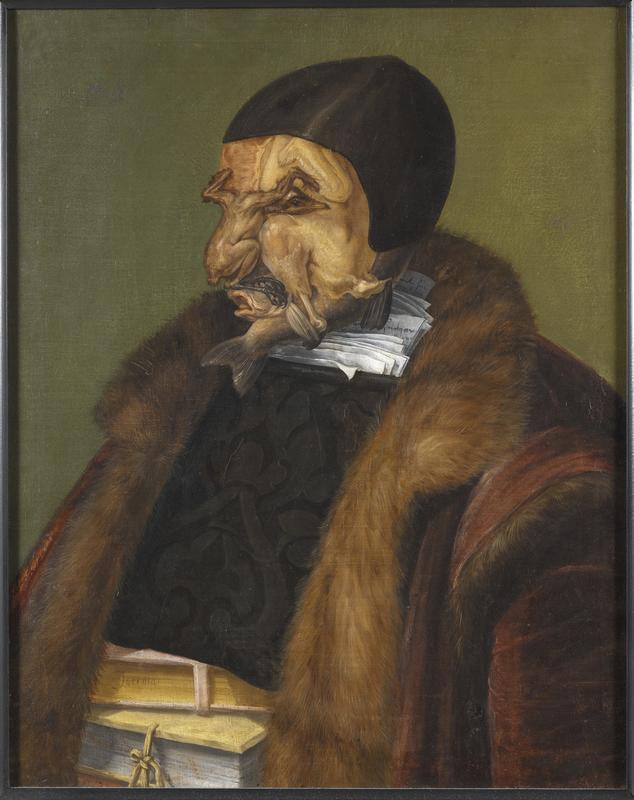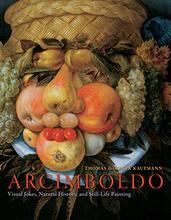More about The Jurist
- All
- Info
- Shop

Contributor
The face of Johann Ulrich Zasius, the sitter for The Jurist, was the butt of a cruel joke played by Arcimboldo.
Also known as The Lawyer, the portrait shows a face mangled by the "French disease," syphilis, which French, and other, soldiers would bring back from the front as a report of their "conquests" in the "field of battle." Zasius lamented that he had wasted his youthful years, convinced that he was a reincarnated form of Bacchus, the Roman deity of drunkenness and sex, who supernaturally avoided STDs. A bust in Zasius's hometown shows his "rough facial features." In this awful case, the whole face of Zasius was "ruined," and "only a few miserable hairs were left on his chin."
Arcimboldo's accurate still-life composition made everyone in the court of the Prague Habsburg Emperor Rudolf II, where Arcimboldo was court painter and Zasius was an accountant, recognize Zasius immediately, evoking great laughter and pleasure in the Emperor. Although monarchs assume their roles by the doctrine of Divine Providence, in many cases, like this one, monarchy often ends up more like the reign of Jabba the Hutt. The artist was so proud of his work that he signed and dated it on the back (maybe not the kind of karma you would want?). You reap what you sow, and one of Rudolf II's illegitimately sown seeds grew up to be an extremely violent man named Don Julius Caesar d'Austria, who his father eventually sentenced to life imprisonment.
To this day, many Germans are proud of Zasius, and he was the major figure in updating German law for a new era in which people saw Germany as the most civilized nation on earth, until the awkward 20th century, of course. Hebrew does not have curse words like English, but it does have phrases to curse people, and one of the harshest is "may his/her name be blotted out." Certainly the Rhineland Jews spoke words like those against Zasius who scholars call one of the pre-eminent figures of German humanism, with his pal, Erasmus. If he's a humanist, the barrier to entry must be pretty low: of his infamous rulings against Jews was one setting a precedent to baptize babies against their parents' will. He named it De Judaeis parvulis babtizandis quaestiones tres, and stated his opinion that a boy in Freiburg, Zasius's place of residence, was legally converted by church authorities against the wishes of his parents, because Jews, with an older, but nonetheless less accurate view of Divine Providence, have no right to "stand in the way of the inheritance of eternal life."
Having failed to mount campaigns to convert large nations by force, in the context of the "Holy Roman Empire," we were "servants of the emperor," and thus, all of our rights rested entirely on the Emperor's Grace, and he could withdraw them at any time. The Jewish community in Prague was desperate, and, as legend has it, an ancestor of the great violinist Yehudi Menuhin, a Rabbi nicknamed the Maharal, summoned the Golem, made from clay, with some very high-tech Divine Names to defend the Jewish people from the pogroms of Zasius and his brothers-in-arms.
Sources
- Art Bulletin of Nationalmuseum, Stockholm. Stockholm: Nationalmuseum, 2010.
- Breßler, Steffen. "Zasius." Homepage von Steffen Breßler, 2000, https://web.archive.org/web/20020816232542/http://www.geocities.com/leg….
- Harms, Wolfgang. Antike und Abendland: Beiträge zum Verständnis der Griechen und Römer und ihres Nachlebens. Berlin: de Gruyter, 1991.
- Kaufmann, Thomas DaCosta. L'École de Prague: la peinture à la cour de Rodolphe II. Paris: Flammarion, 1985.
- Leiman, Shnayer Z. "The Adventure of the Maharal of Prague in London: R. Yudl Rosenberg and the Golem of Prague." Tradition: A Journal of Orthodox Jewish Thought 36, no. 1 (2002): 26-58.
- Neiva, Eduardo. Mythologies of Vision: Image, Culture, and Visuality. New York: Peter Lang, 1999.
- Rowan, Steven W. "Ulrich Zasius and the Baptism of Jewish children." The Sixteenth Century Journal 6, No. 2 (Oct., 1975): 3-25.
- Seckel, Al. Masters of Deception: Escher, Dalí & the Artists of Optical Illusion. New York: Sterling, 2004.
Featured Content
Here is what Wikipedia says about The Jurist (Arcimboldo)
The Jurist (Italian: L'Avvocato), also known as The Lawyer, is an oil-on-canvas painting by Italian artist Giuseppe Arcimboldo, painted in 1566.
It shows a member of the legal profession, whose facial features are depicted using meat and fish, and whose body is composed of legal documents. Two versions of the painting exist; the first, from 1566, is held by the National Museum of Fine Arts (Nationalmuseum) in Stockholm (acquired from a collection at Gripsholm Castle in 1866), and a later version is held by a private collector in Milan.
Arcimboldo was employed as court painter to Maximilian II and was already well established as an artist by the time he created The Jurist. He was known for his innovative style, particularly for his portraits in which the subjects were composed of everyday objects. His fantastical and imaginative paintings somewhat foreshadowed the Surrealist movement of the 20th century, but were also appreciated as part of the Mannerist tradition of his own time. His series of paintings, The Four Seasons, which depicted the changing seasons as series of portraits composed of seasonal plants, were particularly popular, and he even created a portrait of Rudolf II (entitled Vertemnus) in the same style.
The features of the face are represented by the plucked carcasses of poultry and the sneering mouth by fish. It is not known if the subject is a caricature of the legal profession in general or based on a real jurist of the time. The German jurist Ulrich Zasius is normally suggested as the subject; the Nationalmuseum lists the picture in its catalogue as The Lawyer (Ulrich Zasius), but Calvin has also been suggested. Arcimboldo's portrait of The Librarian (Il Bibliotecario), painted the same year, has a more noble aspect, although this portrait too has been interpreted as a parody of librarianship, book collectors, and intellectualism.

Check out the full Wikipedia article about The Jurist (Arcimboldo)















